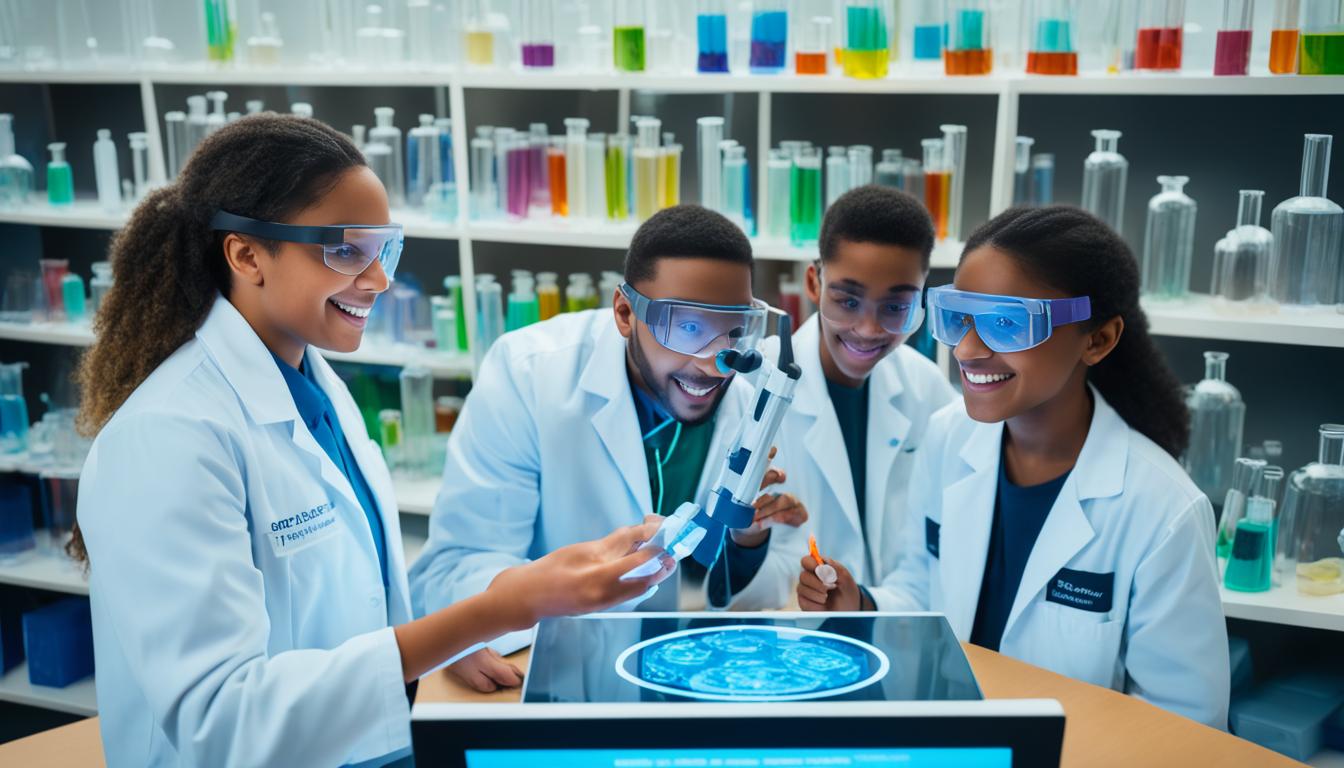Science education plays a critical role in shaping the minds of young learners and preparing them for the challenges of the future. As technology continues to advance at a rapid pace, it has become an indispensable tool in empowering the next generation of scientists. By leveraging the power of technology, we can unlock a world of opportunities for young minds, enabling them to explore, experiment, and discover the wonders of science in ways never before possible.
With technology at their fingertips, students can delve deeper into scientific concepts, engage in interactive learning experiences, and broaden their knowledge through virtual labs and simulations. The role of technology in science education goes beyond just providing access to information; it ignites curiosity, fosters critical thinking, and nurtures creativity.
In this article, we will explore the transformative role of technology in science education, focusing on how it empowers young minds and shapes their journey of scientific discovery. We will delve into the advancements in STEM education, the intersection of technology and mentorship, the importance of research opportunities, and the role of innovative learning resources. Lastly, we will discuss how technology enables global connections and fosters a passion for science among the next generation of scientists.
Key Takeaways:
- Technology plays a crucial role in empowering young minds in science education.
- Interactive platforms and virtual labs enhance science learning experiences.
- Mentorship opportunities supported by technology provide guidance and support.
- Research opportunities foster critical thinking skills and global impact.
- Innovative learning resources revolutionize science education in classrooms.
Empowering Future Scientists: Technological Advancements in Youth STEM Education
In today’s rapidly evolving world, technological advancements play a crucial role in empowering future scientists. The integration of technology in youth STEM (Science, Technology, Engineering, and Mathematics) education has opened up new horizons for young learners, stimulating their curiosity and creativity in the digital age.
Stimulating Curiosity and Creativity in the Digital Age
With the rise of interactive platforms and virtual labs, students now have access to unique learning experiences that transcend the traditional boundaries of the classroom. These digital tools provide hands-on opportunities to engage with scientific concepts, encouraging experimentation, and fostering critical thinking. By immersing themselves in virtual environments, young minds are empowered to explore and question, nurturing their curiosity and igniting a lifelong passion for scientific discovery.
Interactive Platforms and Virtual Labs in Science Learning
The integration of interactive platforms and virtual labs revolutionizes the way students learn and interact with scientific concepts. These platforms offer a dynamic and immersive experience, enabling learners to manipulate virtual experiments, analyze data, and draw conclusions. By bridging the gap between theory and practice, students develop a deeper understanding of complex scientific principles and enhance their problem-solving skills. The flexibility and accessibility of these virtual environments also level the playing field, making science education more inclusive and providing opportunities for students from diverse backgrounds to engage actively.
Science Programs for Youth and Their Lifelong Impact
Science programs specifically designed for youth have a lifelong impact on their education and career development. These programs introduce young learners to the scientific method, encourage collaboration and teamwork, and provide mentorship and guidance from experienced professionals. Through experiential learning, students gain invaluable insights and perspectives, preparing them to tackle real-world challenges. By fostering a passion for science early on, these programs empower future scientists to make groundbreaking discoveries, contribute to the advancement of society, and shape the world around them.
The Intersection of Technology and Mentorship in Science Education
In today’s digital era, technology plays a significant role in transforming various aspects of our lives, including education. Science education, in particular, has seen a remarkable evolution thanks to the integration of technology. One area where technology has made a profound impact is in the realm of mentorship.
Mentorship has long been recognized as a valuable tool for nurturing young minds and guiding them in their educational journey. Traditionally, mentorship involved in-person interactions and limited access to resources. However, with the advent of technology, mentorship has taken on a new dimension.

Technology has bridged the gap between mentors and mentees, providing a wide range of opportunities for collaboration, guidance, and support. Through various digital platforms and tools, aspiring scientists and students are now able to connect with experienced mentors from around the world, breaking down geographical barriers and expanding their horizons.
Online mentorship programs not only provide young scientists with access to expert advice but also offer them a virtual space to seek guidance and discuss ideas. This virtual mentorship fosters a sense of community and enables mentees to form connections, amplifying the learning experience.
Furthermore, technology has revolutionized the way mentorship is delivered, allowing for greater flexibility and personalization. Mentors can now leverage digital resources such as online courses, interactive simulations, and virtual laboratories to enhance the learning experience for their mentees. These tools provide hands-on learning opportunities and empower young minds to explore scientific concepts in an engaging and immersive way.
Moreover, technology facilitates continuous mentoring, enabling mentors to provide real-time feedback and support to their mentees. Whether through video calls, instant messaging, or collaborative online platforms, mentors can maintain regular communication and foster a strong mentor-mentee relationship. This constant guidance and interaction contribute to the holistic development of young scientists.
Overall, the intersection of technology and mentorship in science education brings numerous benefits to young scientists. It expands access to mentorship opportunities, offers a platform for collaboration and knowledge-sharing, and enhances the overall learning experience. By harnessing the power of technology, we can truly empower the next generation of scientists and nurture their passion for scientific discovery.
Fostering Critical Thinking Through Research Opportunities for High Schoolers
Research opportunities play a crucial role in fostering critical thinking skills among high school students. By engaging in student-led scientific inquiry, young minds can develop essential analytical and problem-solving abilities that will benefit them throughout their academic and professional careers.
Student Research Initiatives and Their Global Influence
Student research initiatives provide high schoolers with the chance to explore their scientific interests and contribute to the global scientific community. As students delve into research projects, they gain valuable experience in designing experiments, collecting and analyzing data, and drawing meaningful conclusions.
These initiatives often extend beyond the confines of the classroom, offering students the opportunity to collaborate with experts in the field and even present their findings at international conferences. Through these experiences, high schoolers gain a deeper understanding of the global impact of scientific inquiry and develop a sense of responsibility as future contributors to scientific knowledge.
The Significance of Student-Led Scientific Inquiry
Student-led scientific inquiry allows high schoolers to take ownership of their learning and explore topics that spark their curiosity. By engaging in hands-on research, they develop a deep understanding of the scientific method and cultivate essential skills such as critical thinking, problem-solving, and data analysis.
Moreover, student-led scientific inquiry fosters creativity and innovation. When students have the freedom to explore and experiment, they can think outside the box and come up with unique solutions to real-world problems. This type of inquiry-based learning encourages students to ask thoughtful questions, develop hypotheses, and apply their knowledge to design and conduct experiments.
| Benefits of Student Research Initiatives | Effect on High Schoolers | Impact on Society |
|---|---|---|
| 1. Develops critical thinking skills | 1. Enhances problem-solving abilities | 1. Contributes to scientific knowledge |
| 2. Enhances problem-solving abilities | 2. Fosters scientific curiosity | 2. Advances research in various fields |
| 3. Encourages creativity and innovation | 3. Promotes lifelong learning | 3. Inspires future generations of scientists |
By providing high schoolers with research opportunities, educators and mentors nurture a generation of critical thinkers who are well-equipped to tackle complex challenges and make significant contributions to various scientific disciplines.
Nurturing the Next Generation of Researchers with Hands-On Learning in STEM
In today’s rapidly evolving world, nurturing the next generation of researchers has become paramount. By providing hands-on learning experiences in STEM education, we can spark curiosity, inspire creativity, and ignite a passion for research in young minds. Hands-on learning allows students to actively engage with scientific concepts, conduct experiments, and solve real-world problems, equipping them with the necessary skills and knowledge for future scientific endeavors.
Hands-on learning goes beyond traditional classroom instruction by providing students with practical, experiential opportunities to explore STEM subjects. Through hands-on activities, students can learn by doing, actively participating in the scientific process. This active engagement fosters a deeper understanding of scientific principles and cultivates critical thinking skills.
One effective way to incorporate hands-on learning into STEM education is by using laboratory experiments. These experiments allow students to apply theoretical knowledge to real-world situations, make observations, collect data, and draw conclusions. By engaging in hands-on experiments, students develop important research skills, such as problem-solving, data analysis, and scientific reasoning.

Another hands-on learning approach is project-based learning, where students work on multidisciplinary projects that require them to integrate STEM concepts and skills. Through project-based learning, students learn how to collaborate, communicate, and think critically, while addressing complex challenges. This experiential learning fosters creativity and innovation, as students develop their own research questions and design experiments to find answers.
Hands-on learning experiences in STEM education not only nurture the next generation of researchers but also foster a lifelong love for inquiry and discovery. By providing students with opportunities to explore and engage in scientific research, we are preparing them to become future scientists, engineers, and innovators.
STEM education plays a crucial role in equipping students with the skills and knowledge needed for the careers of the future. By integrating hands-on learning into STEM curriculum, we can ensure that students are well-prepared to tackle the complex challenges of our world. Through hands-on learning, we empower young minds, nurturing their curiosity and passion for research, and shaping the next generation of researchers.
Mentorship Opportunities for Students Leading to STEM Career Development
In order to foster the growth and development of aspiring young scientists, mentorship opportunities play a crucial role in their journey towards a successful STEM career. Mentorship offers valuable guidance, support, and inspiration, enabling students to navigate the complexities of the STEM field and discover their true potential.
One of the most effective ways to provide mentorship to young inventors is by pairing them with industry experts. This collaboration allows students to learn from experienced professionals who can provide real-world insights and practical knowledge. By engaging with industry experts, students gain a deeper understanding of the challenges and opportunities within their chosen field, which can greatly enhance their STEM career development.
Moreover, role models in STEM play a significant role in inspiring and shaping the future career paths of young scientists. When students have the opportunity to interact with and learn from successful individuals in their desired field, they are more likely to visualize themselves in similar positions and aspire to achieve similar accomplishments. These role models serve as beacons of inspiration, guiding students towards their goals and motivating them to overcome obstacles along the way.
Pairing Young Inventors with Industry Experts
Pairing young inventors with industry experts creates a symbiotic relationship that benefits both parties. For young inventors, the opportunity to work closely with professionals who have hands-on experience in their respective fields is invaluable. It provides them with mentorship, guidance, and exposure to real-world challenges. Through this partnership, students can gain insights into industry trends, develop practical skills, and forge connections that may open doors to future opportunities.
Industry experts, on the other hand, have the chance to contribute to the development of the next generation of innovators. By sharing their knowledge and expertise, they can help shape the future of their industry. Through mentorship, these experts can pass on valuable insights, inspire creativity, and foster the growth of young talent. This exchange of expertise between industry professionals and young inventors creates a collaborative and nurturing environment conducive to STEM career development.
Role Models in STEM: Inspiring Future Career Paths
Role models play a significant role in the lives of students pursuing STEM careers. They offer inspiration, guidance, and a tangible example of what is achievable within their chosen field. Through the stories and achievements of role models, students can visualize their own potential and gain the confidence to pursue their passions.
When students have role models who have achieved success in their desired STEM careers, they are more likely to believe in their own abilities and strive for greatness. Role models provide a sense of direction, showing students the path to success and highlighting the steps they need to take to reach their goals. By sharing their experiences and offering advice, role models in STEM become invaluable mentors, guiding and supporting students along their STEM career journey.
| Benefits of Mentorship Opportunities for Students | Benefits for Industry Experts |
|---|---|
|
|
The Role of Technology in Connecting Young Minds with Science Outreach Programs
Technology plays a crucial role in connecting young minds with science outreach programs, providing unprecedented access and opportunities for engagement. Through innovative digital platforms and tools, technology facilitates the sharing of knowledge and resources, enabling young learners to participate in science initiatives and explore their scientific interests.
One way technology connects young minds with science outreach programs is by breaking down barriers to entry. With just a few clicks, students can access a wide range of science resources, including online courses, educational videos, and virtual experiments. This accessibility promotes inclusivity and encourages young learners from diverse backgrounds to explore their passion for science.
Furthermore, technology fosters engagement and participation among young minds through interactive virtual experiences. Science outreach programs now leverage virtual reality (VR) and augmented reality (AR) technologies to create immersive learning environments. Students can observe scientific phenomena up close, conduct virtual experiments, and collaborate with peers from around the world, enhancing their understanding and enthusiasm for science.

The role of technology in connecting young minds with science outreach programs extends beyond access and engagement. Digital platforms provide a vast network of science professionals, mentors, and industry experts who can guide and inspire aspiring scientists. Through online mentorship programs and remote collaborations, technology connects young learners with experienced professionals, allowing them to benefit from valuable insights and guidance in their scientific pursuits.
In conclusion, technology serves as a catalyst in connecting young minds with science outreach programs. By harnessing its power, we can empower the next generation of scientists and create a global community of curious, innovative, and passionate learners.
Building a Global Network of Aspiring Scientists through Tech Education
In today’s interconnected world, tech education plays a crucial role in building a global network of aspiring scientists. By harnessing the power of technology, young minds can access worldwide educational resources, engage in virtual collaboration, and participate in international science fairs.
Access to Worldwide Educational Resources
Tech education opens the doors to a vast array of educational resources from around the globe. No longer limited by geographical boundaries, aspiring scientists can explore a wealth of knowledge and expertise across various disciplines. Online platforms provide access to virtual libraries, research databases, and educational videos, empowering students to conduct in-depth research and expand their understanding of scientific concepts.
Virtual Collaboration and International Science Fairs
Thanks to tech education, virtual collaboration among aspiring scientists has become more accessible and impactful than ever before. Through online platforms and communication tools, students can connect with peers from different countries, exchange ideas, and collaborate on projects. These virtual collaborations not only foster a sense of global community but also encourage the exchange of diverse perspectives and approaches to scientific problem-solving.
Furthermore, tech education enables aspiring scientists to participate in international science fairs without the need for physical presence. Virtual science fairs provide a platform for students to showcase their research, receive feedback from experts, and gain recognition on a global stage. This exposure not only boosts their confidence but also instills a sense of pride and motivation to pursue further scientific endeavors.
| Benefits of Building a Global Network of Aspiring Scientists | Opportunities for Collaboration and Growth | Enhancement of Research and Problem-Solving Skills | Exposure to Diverse Cultural Perspectives |
|---|---|---|---|
| Expanded access to knowledge and resources | Exchange of ideas and innovative approaches | Development of critical thinking and analytical skills | Increased understanding and appreciation of cultural diversity |
| Elevated opportunities for mentorship and guidance | Ability to tackle complex challenges collaboratively | Improved proficiency in conducting scientific research | Preparation for a globalized and interconnected world |
Revolutionizing Classrooms with Innovative Science Education Resources
In today’s rapidly evolving world, technology is revolutionizing classrooms and transforming the way we approach science education. With the integration of cutting-edge tech tools into the curriculum, educators have the opportunity to provide innovative and engaging learning experiences for students. By incorporating gamification, we can enhance student engagement and foster a love for science.
One of the key benefits of integrating technology into science education is the ability to provide students with access to innovative resources that enhance their learning journey. From virtual labs and simulations to interactive apps and online platforms, these resources offer a hands-on and immersive experience that goes beyond traditional textbooks.

“Integrating cutting-edge tech tools into the curriculum opens up a world of possibilities for both teachers and students. It allows us to bridge the gap between theory and practice, enabling students to explore and experiment in ways that were never before possible.”
By incorporating gamification elements into science education, we can further enhance student engagement and motivation. Gamification brings an element of fun and friendly competition into the classroom, tapping into students’ natural inclination to play and learn at the same time. Through interactive challenges, rewards, and leaderboards, students are motivated to actively participate and excel in their scientific exploration.
Furthermore, gamification encourages collaboration and teamwork, providing opportunities for students to work together on problem-solving tasks and projects. This not only enhances their understanding of scientific principles but also develops important skills such as critical thinking, communication, and creativity.
By revolutionizing classrooms with innovative science education resources, integrating cutting-edge tech tools into the curriculum, and incorporating gamification, we can create a dynamic and engaging learning environment that inspires students to explore the wonders of science and pursue careers in STEM disciplines.
Enabling Global Impact with Student Research Opportunities
In today’s rapidly evolving world, student research opportunities play a crucial role in enabling global impact. By providing young researchers with the chance to tackle real-world challenges through youth-led innovation, we are empowering the next generation to make significant contributions to science and address pressing issues facing our planet.
Tackling Real-World Challenges with Youth-Led Innovation
Student-led research allows young minds to engage directly with real-world challenges. Through their innovative thinking and fresh perspectives, these young researchers can propose creative solutions and apply their knowledge to make a tangible difference. By fostering a culture of youth-led innovation, we are encouraging out-of-the-box thinking and empowering students to become active agents of change.
Whether it’s developing sustainable technologies, addressing climate change, or finding solutions to health crises, student researchers are at the forefront of driving impactful change. These opportunities not only provide practical experience but also instill invaluable skills such as critical thinking, problem-solving, and collaboration that will benefit them throughout their lives.
Celebrating Young Researchers’ Contributions to Science
It’s essential to recognize and celebrate the contributions of young researchers to the field of science. Their fresh perspectives, innovative ideas, and unwavering dedication offer new insights that can shape the future of scientific discovery. By highlighting their accomplishments, we inspire other students to pursue their own research journeys and foster a sense of passion and curiosity within the next generation of scientists.
When we celebrate young researchers, we also encourage diversity and inclusivity in the scientific community. By showcasing the achievements of underrepresented groups, we inspire others from similar backgrounds to pursue scientific careers and contribute their unique perspectives.
Through student research opportunities, we can harness the untapped potential of young minds, empower them to tackle global challenges and make a lasting impact on the world. Let’s continue to support and invest in the future of science by providing students with the resources and mentorship they need to thrive.
Igniting a Passion for Science with Inspiring the Next Generation of Scientists
As we continue to explore the transformative power of technology in science education, one crucial aspect is igniting a passion for science and inspiring the next generation of scientists. By instilling curiosity and enthusiasm in young minds, we can cultivate a new wave of scientific thinkers who will drive innovation and address the world’s most pressing challenges.
There are various methods and initiatives that can be employed to ignite this passion for science. One approach is to provide hands-on and interactive learning experiences that engage students directly with scientific concepts. Through experiments, projects, and demonstrations, students can see the real-world applications of science and develop a genuine interest in the subject.
Another effective way to inspire the next generation of scientists is by introducing them to role models who have made significant contributions to their respective scientific fields. By showcasing the achievements of renowned scientists and researchers, young minds can envision themselves making similar strides and fuel their own aspirations.
Additionally, mentorship programs play a pivotal role in nurturing young scientists. By connecting students with seasoned professionals, these programs provide guidance, support, and valuable insights that can shape their scientific journeys. Through mentorship, aspiring scientists gain access to expertise, networking opportunities, and valuable advice that can help them navigate the complexities of pursuing a scientific career.
Furthermore, it is essential to create inclusive and diverse learning environments that celebrate scientific achievements from all backgrounds. By promoting diversity in science and showcasing the contributions of underrepresented groups, we can inspire a more inclusive and equitable future for scientific exploration.
By implementing these initiatives and approaches, we can ignite a passion for science within the next generation. With their enthusiasm and dedication, these future scientists have the potential to drive groundbreaking discoveries, advance our understanding of the world, and shape a brighter future for all.
Conclusion
In conclusion, the role of technology in science education is paramount in empowering young minds and shaping the future of scientific learning. Through technological advancements, such as interactive platforms, virtual labs, and access to worldwide educational resources, we have witnessed the immense impact on youth STEM education. These advancements stimulate curiosity and creativity in the digital age, allowing young learners to explore and engage with science in a whole new way.
Moreover, technology has made it possible to connect aspiring scientists with mentorship opportunities, pairing them with industry experts who provide guidance and inspiration. The incorporation of gamification and innovative science education resources has transformed classrooms, enhancing engagement and fostering critical thinking skills among high school students.
By enabling student research initiatives and embracing hands-on learning experiences, we are nurturing the next generation of researchers. Young minds are now tackling real-world challenges through youth-led innovation, making significant contributions to scientific knowledge and global impact. This, coupled with the celebration of their achievements, further ignites a passion for science and inspires others to follow in their footsteps.
In summary, technology has revolutionized science education, providing new avenues for learning, collaboration, and mentorship. The future of science education is bright, as we continue to leverage technology in empowering young minds and preparing them for a world full of possibilities and discoveries.
FAQ
What is the role of technology in science education?
How do science programs for youth impact their lifelong learning?
How does technology enhance mentorship in science education?
Why are research opportunities important for high school students?
How does hands-on learning in STEM education nurture the next generation of researchers?
How can mentorship opportunities lead to STEM career development?
What is the role of technology in connecting young minds with science outreach programs?
How does tech education build a global network of aspiring scientists?
How can innovative science education resources revolutionize classrooms?
How do student research opportunities enable global impact?
How can we ignite a passion for science and inspire the next generation of scientists?
Source Links
- https://underline.io/news/80-the-crucial-role-of-youth-in-advancing-science-and-technology
- https://medium.com/@zbourmada/empowering-youth-through-tech-education-bridging-the-digital-divide-8af745f3273b
- https://www.linkedin.com/pulse/empowering-tomorrows-innovators-crucial-role-stem



